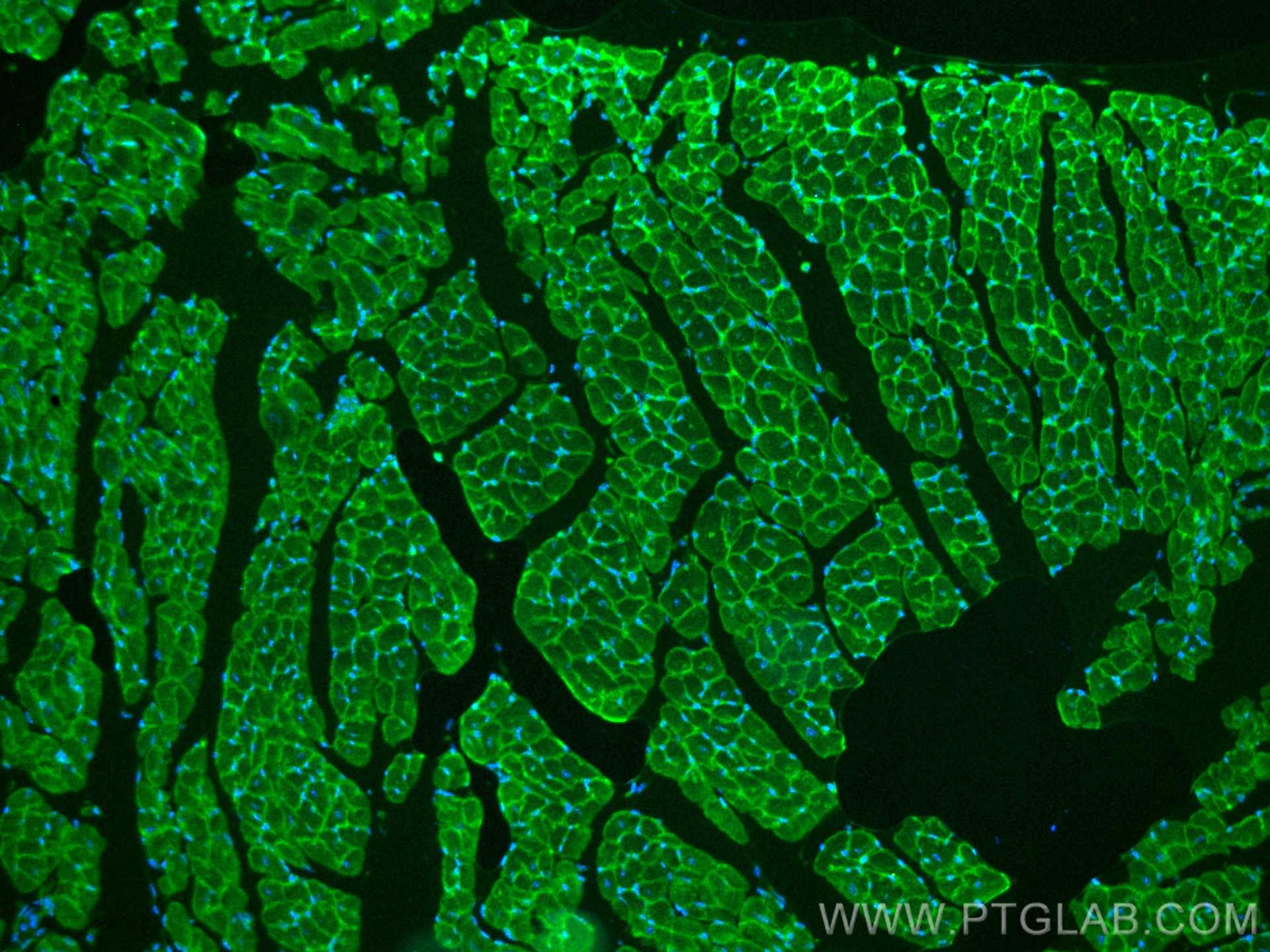验证数据展示
经过测试的应用
| Positive IF-P detected in | mouse heart tissue |
推荐稀释比
| 应用 | 推荐稀释比 |
|---|---|
| Immunofluorescence (IF)-P | IF-P : 1:50-1:500 |
| It is recommended that this reagent should be titrated in each testing system to obtain optimal results. | |
| Sample-dependent, Check data in validation data gallery. | |
产品信息
CL488-66735 targets Dystroglycan in IF-P applications and shows reactivity with human, mouse, rat, pig samples.
| 经测试应用 | IF-P Application Description |
| 经测试反应性 | human, mouse, rat, pig |
| 免疫原 |
CatNo: Ag27222 Product name: Recombinant human DAG1 protein Source: e coli.-derived, PET28a Tag: 6*His Domain: 546-895 aa of BC012740 Sequence: VGEKSWVQFNSNSQLMYGLPDSSHVGKHEYFMHATDKGGLSAVDAFEIHVHRRPQGDRAPARFKAKFVGDPALVLNDIHKKIALVKKLAFAFGDRNCSTITLQNITRGSIVVEWTNNTLPLEPCPKEQIAGLSRRIAEDDGKPRPAFSNALEPDFKATSITVTGSGSCRHLQFIPVVPPRRVPSEAPPTEVPDRDPEKSSEDDVYLHTVIPAVVVAAILLIAGIIAMICYRKKRKGKLTLEDQATFIKKGVPIIFADELDDSKPPPSSSMPLILQEEKAPLPPPEYPNQSVPETTPLNQDTMGEYTPLRDEDPNAPPYQPPPPFTAPMEGKGSRPKNMTPYRSPPPYVPP 种属同源性预测 |
| 宿主/亚型 | Mouse / IgG1 |
| 抗体类别 | Monoclonal |
| 产品类型 | Antibody |
| 全称 | dystroglycan 1 (dystrophin-associated glycoprotein 1) |
| 别名 | DAG1, 2B1G12, A3a, AGRNR, Alpha DG Beta dystroglycan |
| 计算分子量 | 97 kDa |
| 观测分子量 | 43 kDa, 30 kDa |
| GenBank蛋白编号 | BC012740 |
| 基因名称 | Dystroglycan |
| Gene ID (NCBI) | 1605 |
| RRID | AB_2934490 |
| 偶联类型 | CoraLite® Plus 488 Fluorescent Dye |
| 最大激发/发射波长 | 493 nm / 522 nm |
| 形式 | Liquid |
| 纯化方式 | Protein G purification |
| UNIPROT ID | Q14118 |
| 储存缓冲液 | PBS with 50% glycerol, 0.05% Proclin300, 0.5% BSA, pH 7.3. |
| 储存条件 | Store at -20°C. Avoid exposure to light. Stable for one year after shipment. Aliquoting is unnecessary for -20oC storage. |
背景介绍
Dystroglycan, also known as DAG1 or DG, was originally isolated from skeletal muscle as an integral membrane component of the dystrophin-glycoprotein complex (DGC). In addition to skeletal muscle, dystroglycan is strongly expressed in heart and smooth muscle, as well as many non-muscle tissues including brain and peripheral nerve (PMID: 12556455). The dystroglycan is involved in a number of processes including laminin and basement membrane assembly, sarcolemmal stability, cell survival, peripheral nerve myelination, nodal structure, cell migration, and epithelial polarization. Dystroglycan consists of two subunits (alpha and beta), which are translated from a single mRNA as a propeptide that is proteolytically cleaved into two noncovalently associated proteins (PMID: 16410545). Alpha-dystroglycan is a 156-kDa extracellular peripheral glycoprotein, while beta-dystroglycan is a 43-kDa transmembrane protein (PMID: 9858474). The 43-kDa beta-dystroglycan can be cleaved into a ~30-kDa form (PMID: 14678802; 18458097; 17255331).
实验方案
| Product Specific Protocols | |
|---|---|
| FC protocol for CL Plus 488 Dystroglycan antibody CL488-66735 | Download protocol |
| IF protocol for CL Plus 488 Dystroglycan antibody CL488-66735 | Download protocol |
| Standard Protocols | |
|---|---|
| Click here to view our Standard Protocols |



